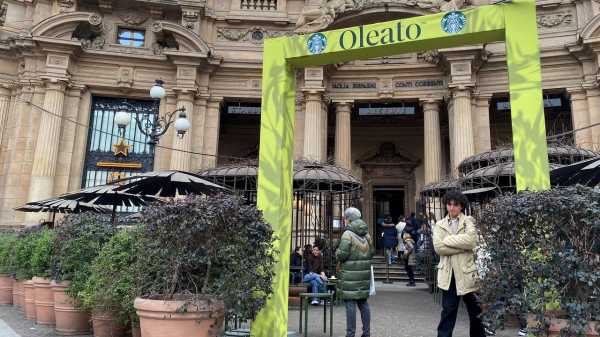
As corporate legend has it, the concept of Starbucks was inspired by a visit that Howard Schultz paid to Milan in 1983. At the time, Schultz was the director of operations and marketing for a local Seattle chain with fewer than a dozen outposts; the stores, the first of which opened in 1971, sold whole beans, leaf teas, and spices in bulk. In Milan for a trade show, Schultz found himself enchanted by the city’s espresso bars. The official version of the story, on the company’s Web site, continues, “The baristas were artists, respected for their craft. And the bars themselves served as a ‘third place’ for customers—welcoming, energetic gathering spaces between home and work that became part of people’s daily routine.” He pitched the company’s leaders upon his return, and, in 1984, the first Starbucks Caffè Latte was poured at an experimental counter in a corner of one of the chain’s locations. The next year, Schultz left the company to open his own chain, called Il Giornale, in homage to one of the Milanese dailies. In 1987, Schultz bought the rights to the Starbucks name, along with six stores. Today, the company has thirty-six thousand locations in eighty countries.
Over the last two decades, Starbucks has become one of the paradigmatic cases of poor succession planning in American business. Schultz first retired as chief executive in 2000, only to return in 2008 to steward the company through the financial crisis; he purged top executives, closed hundreds of underperforming stores, laid off thousands of employees, and led an aggressive expansion effort in China. In 2017, he stepped down again, only to return last year as interim C.E.O. (He’s made it clear in the past three Presidential-election cycles that his personal preference would be to serve not as a company’s chief executive but as the nation’s.) In this most recent stint, he has played the role of the charismatic, visionary entrepreneur drafted once more against his will to rescue the soul of the company from mere accountants. As he put it in a recent interview with CNN’s Poppy Harlow, “There’s a balance, and it’s fragile, that has to be maintained between pushing for self-renewal and reinvention and maintaining the core values of the company, and that’s where companies, and that is where Starbucks, in the past, has lost its way—where it has tilted too much to a place where it’s been too financially oriented, too financially skewed, too focussed on the stock price, and the only way forward for Starbucks is to follow the hearts and minds of our people.” The rhetorical grandiosity suggested he were salvaging a company like Boeing, another troubled colossus of Seattle origin, but cost-cutting under his predecessor hadn’t made Grande Toasted White Chocolate Mochas fall from the sky. That said, he did end the company’s expensive campaign of stock buybacks, and seemed committed to the reinvestment of that capital into the future of Starbucks and its employees.
This April, Schultz will retire for the third—and, he has promised, final—time. Last week, he returned to Milan to unveil his final creative act at the company: Oleato. The Oleato line of beverages features Starbucks coffee infused with extra-virgin olive oil. For the moment, the drinks, which include Oleato™ Caffè Latte, Oleato™ Iced Cortado, Oleato™ Golden Foam™ Cold Brew, Oleato™ Deconstructed, and Oleato™ Golden Foam™ Espresso Martini, are sold exclusively in Italy, and the full line is available only at the Starbucks Reserve™ Roastery in Milan’s Piazza Cordusio, the company’s flagship store in the country. In advance of the Oleato rollout, Schultz said, “Now, there’s going to be people who say, ‘Olive oil in coffee?’ But the proof is in the cup. In over forty years, I can’t remember a moment in time where I’ve been more excited.”
In the CNN interview, which interleaved scenes filmed in a Canarsie housing project, where Schultz was raised, with others shot on location in a gently breezy Sicilian olive grove, Schultz pours a healthy dollop of gleaming green oil into a milk-foaming jug. He tells Harlow, “You really want to spray the coffee into your mouth, get it in there to really enjoy and taste the different flavors, the body, the acidity, in this case the olive oil. If somebody took a blood test of me, I think my blood is coming out gold, I’ve had so much olive oil.” Harlow, who seems vaguely torn between the pleasures of a work junket to southwestern Sicily and the concomitant obligation to drink coffee with olive oil in it, asks Schultz, whose most recent tenure has been riven by bitter, ongoing disputes with a unionizing workforce, the obvious question: “Why is this your last move?”
Schultz replies with an enigmatically folksy smile. “Well, I didn’t plan this, to end my career at Starbucks in the same place I started,” he says. But, he adds, “Coffee’s been around for thousands of years and nobody’s ever thought of mixing the two except me.”
If Schultz and Starbucks have long leveraged their putative association with an Italy of the mind, the Italy of reality has had a more ambivalent relationship with the company. It took years of delays before the company made its Italian début, in part presumably owing to Schultz’s fears that he and his firm would be laughed out of the country. The chain’s presence in Italy was, however, an inevitability, both as a personal totem of Schultz’s success and, according to one local industry observer, to reduce supply-chain costs associated with the shipment of roasted beans to the Continent. Milan’s Starbucks Reserve Roastery, which opened in 2018, was installed in the opulent turn-of-the-century Palazzo delle Poste; constructed of pale-pink stone in the eclecticist style of the nearby Galleria Vittorio Emanuele II, the building first housed the city’s stock exchange and, later, its central post office. With frontage along a wide shopping boulevard that runs from the Piazza del Duomo to the Castello Sforzesco, the store’s sidewalk plaza looks like the overgrown terrarium of an eccentric industrial magnate, with outdoor seating encased in enormous bronze birdcages. Immediately opposite is the country’s first Uniqlo, which opened the following year. Both outlets were inaugurated by lines around the block, and even now they both maintain velvet ropes outside their doors. Starbucks made every effort to respect native ways of life, and the press, obligingly, dwelled less on the threat to local custom than on the restraint on display—a common refrain was “niente Frappuccino.” The baked goods at the Roastery were provided by Princi, a renowned bakery. As the journalist and podcaster Francesco Costa put it in a tweet, “In sum, in Milan they made a normal bar, with croissants from Princi, and they called it Starbucks. A prize for entrepreneurial courage.” He continued, “One day someone will say to these managers that in one out of every two bars in Italy the legendary Italian coffee is disgusting (and there’s no Wi-Fi, and you can’t sit for three hours to work, and the croissants are frozen, et cetera).”
Despite Starbucks’s status as one of the most obvious avatars of globalization, and Schultz’s identification with “neoliberal” principles, Costa’s lukewarm endorsement—or at least contrarian acceptance—of the company’s entrance into the Italian coffee market wasn’t a wholly fringe position. In 2016, a year before the expected arrival of the first Starbucks in Milan, Massimiliano Tonelli, then editorial director of Gambero Rosso, an Italian analogue of the Michelin guide, published an article called “Ten Reasons Why the Arrival of Starbucks in Italy Isn’t a Catastrophe.” Tonelli writes, “Italy isn’t the largest consumer of coffee in the world per capita, but in all likelihood it’s the country where this beverage has the most crucial and irrefutable social, cultural, and anthropological role. However, as has happened to many other Italian specialties, this, too, has been mistreated and humiliated over the years, to the point of becoming a shadow of its former self.”
If you’re going to criticize Starbucks, Tonelli continues, you have to take into account the reality that, “today in Italy, on average people drink bad coffee, and they do it in contexts that are inadequate, slovenly, and substandard from the point of view of both the consumer experience and the service.” He goes on to outline what the average Italian bar—there are, of course, plenty of exceptional counterexamples—might have to do to compete with its unwelcome competition: whereas Starbucks workers are trained to be polite, some Italian waiters and baristas display “a world-class rudeness.” Starbucks gives you a receipt, so you know that they paid their taxes; at Italian bars, not so much. Starbucks coffee might be expensive, but Italian coffee is underpriced—usually about a euro for an espresso taken standing up; any significant increase and Italians would unite behind the barricades—which means that someone along the way is being exploited. And Starbucks workers might not be paid particularly handsomely but they have actual contracts, they’re paid regularly, and they have benefits, little of which applies to many Italian bar employees. In an Italian bar, Tonelli writes, you get menacing looks if you overstay your immediate welcome. “The average bar is immutably conceived for a clientele of functionaries or bureaucrats given an endless series of coffee breaks, each lasting thirty seconds.” Starbucks, on the other hand, is a place to sit, work, socialize, meet people, and leave precisely whenever you want. As far as Tonelli was concerned, Starbucks had already shown a greater respect and reverence for Italian tradition than had his compatriots. The company, he concludes in the piece, “won’t be a threat to the Italian bar ‘industry,’ but with any luck an opportunity and a stimulus to improve.”
A defrappucinoed Starbucks at last appeared two years later. Three years after that, in 2021, Tonelli determined that Italy’s bars had failed to rise to the occasion. In La Repubblica, he published a provocation—“Coffee, Italy’s Most Resounding Gastronomic Self-Deception”—that was taken as an affront to the nation’s dignity. He wrote, “From Naples to Trieste, we’re convinced that our espresso is good, made how it should be, orthodox. While that of all the other countries around us, from France to Germany all the way to the United Kingdom, is undrinkable slop.” There is, however, simply no reason for this chauvinistic sense of superiority: “in fact, it’s because of precisely this arrogance that in Italy one currently drinks the worst coffee in the world.” Italians have been kidding themselves. He writes, “That drink that we have banalized and transformed into a sort of medicine to guzzle rapidly on our feet is no longer coffee: it’s an extraction of burnt beans, charred by a tawdry process.”
Was the solution to the wretched state of Italian coffee hiding in plain sight? Howard Schultz, having taken his original inspiration from Italy’s coffee culture, had now returned, in the long, extended, intermittent twilight of his career, to bestow unto Italy an idea that, by all rights, should have been obvious to Italians for centuries.
In interviews, Schultz has spoken about the Oleato idea as if he were coming full circle. The whole thing appears to have happened very quickly. In September, 2022, Schultz was visiting an olive-oil producer in Sicily, who told him that many Sicilians are wont to take a tablespoon of olive oil each morning for their health. Schultz immediately took up the practice himself, though, at a very robust sixty-nine, he already had the Bransonesque vigor of a moisturized billionaire. He was drinking his olive oil in the morning; he already drank his coffee in the morning; why not, he realized, just put the olive oil into the coffee? It was, by his account, a no-brainer, and it does seem as though the number of brains involved was narrowly circumscribed. In the CNN interview, Schultz tells Harlow, “We’ve discovered something quite extraordinary.”
Harlow looks at him as a light sirocco plays with her hair. “You think this transforms coffee?”
Schultz doesn’t hesitate at all: “I know it’ll transform the coffee industry. Very few people outside of Starbucks have tasted it. No consumer research whatsoever. Nothing.”
Harlow asks, “Isn’t that a risk?”
Schultz, with unruffled confidence, shakes his head and grins. “I don’t think so.”
CNN cuts to an image of bottles of something, presumably short-lived and lost to history, called Mazagran. Harlow asks, “You’re sure this won’t go the way of sparkling coffee?”
Schultz replies, “No, no, no, the future of the company today is based on customization, so people are going to add a tablespoon of Partanna extra-virgin olive oil into their drink, I’m sure of it.”
On a cold, drizzly, dark Monday morning a few days after the Oleato line was launched, I persuaded Roberto, my Italian father-in-law—who generally orders coffee in America only to kvetch about it—to join me at the Starbucks Reserve Roastery in Piazza Cordusio. The interior is cavernous but well lit, with gold-seamed, white-marble bars, a hand-chiselled terrazzo floor, and a dizzying array of serpentine copper pipes that lead from the central roasting machines to the service areas, like pneumatic tubes in an antiquated bank. It was before 8 A.M., and we had the place almost entirely to ourselves; the tourists and workers who make up most of the city-center traffic had yet to arrive. The entire store was emblazoned with detergent-green bilingual marketing for the Oleato line: “A revolutionary new coffee ritual bringing together an alchemy of the finest ingredients nature has to offer, Starbucks Arabica coffee beans and Partanna cold-pressed extra virgin olive oil. Velvety smooth. Deliciously lush. Oleato is coffee uplifted.” Roberto made it abundantly clear to the cashier that he was ordering an Oleato under some duress; the cashier said something muted and noncommittal about how the line had, in fact, been selling very well. This seemed auspicious. As we waited at the counter for the baristas to emulsify our olive oil, Roberto once again tried to draw them out on the subject of the Oleato. At a normal Italian bar, any given barista would need little excuse to offer an exaggerated opinion about anything, but the Starbucks employees were apparently trained to keep their personal views to themselves, and refused to take the bait.
We took our drinks to a high table and perched on dark wooden stools polished to a lustrous gloss. Roberto looked down at the coffees and steeled himself. He said, “For an Italian, where coffee is a religion, this feels like a heresy.” We each took a small sip. “It’s really a lot of oil,” he said. He was trying to be diplomatic; years ago, I’d enjoyed the brief fashion for yak-butter coffee, which he’d found appalling, and he seemed to think that I might, in turn, appreciate olive-oil coffee. His diplomacy, however, was unnecessary. We took another small sip, and he could no longer conceal his grimace. “It’s really very much a lot of oil, and it’s very persistent, and very strong.” We took a break, and, as we sat and looked uneasily at each other, the buzzsaw of the coffee receded and left in its unctuous wake something fulsome and blubbery, a sensation which only intensified with the passage of time. Roberto pushed a hunk of his cinnamon roll in my direction, with the suggestion that it might help cut through the slick, oleaginous sediment that seemed likely to coat our mouths in perpetuity. There was little to say but that it tasted like a large spoonful of olive oil in coffee.
It’s unclear what to make of Schultz’s decision to conclude his tenure as one of America’s most successful C.E.O.s with the promise that, in the near future, everyone will be able to walk into a Starbucks and ask for olive oil in their coffee. Was it an elaborate distraction from the company’s labor troubles? Was it a well-intended but perhaps ill-considered signal that Starbucks, symbol of thoroughgoing homogeneity, was preparing to offer a near-limitless horizon of personalized experiences? Perhaps the most generous interpretation is that he wanted to communicate to more cautious business leaders that sometimes it was within the executive warrant to do something extravagantly bizarre. Had the company done any of the usual consumer research, they would presumably have discovered that, from any rational market-oriented perspective, this was a terrible business decision. But maybe Schultz, like so many of us, is terminally nauseated by life in a consumer environment that has been focus-grouped to death. Perhaps Bob Iger, another C.E.O. returnee, will order the development of the Olive Oil Cinematic Universe. I will never order another Oleato again—and, over the three unhurried hours that I spent doing nothing in the store, I witnessed no one else do so—but, in a perverse way, it’s impossible to be unhappy that it exists in the world.
Roberto turned to me and said, “I can’t wait to go back to the office to have a proper cup of coffee.” Then he thought again, and gestured for us to return to the bar. “Due espressi buoni,” he said, and once again the cashier held his own opinion in reserve. We took the regular coffees. They were perfectly fine. ♦
Sourse: newyorker.com






